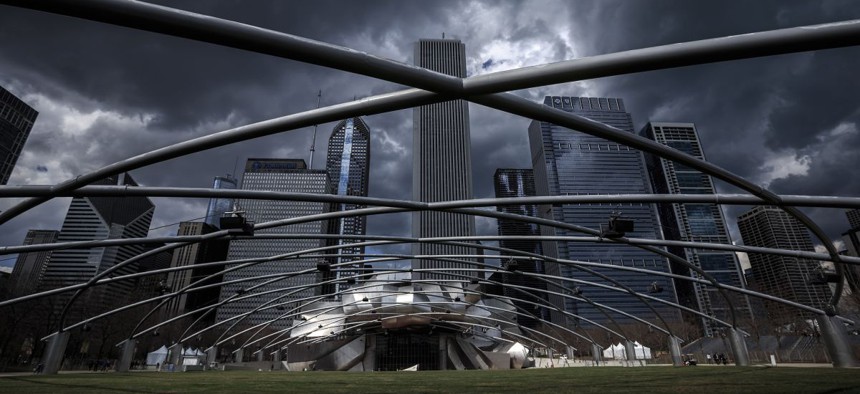What's Causing Chicago’s Homicide Spike?

Chicago Shutterstock
President Trump is vowing to “send in the Feds,” but researchers aren’t convinced they understand the rise, or how to stop it.
President Trump threatened Tuesday night to use federal power to “fix the horrible carnage” unfolding in Chicago, referring to the city’s extraordinary recent spike in homicides.
The problem is real: 762 people were murdered in Chicago last year, a stunning 58 percent jump in homicides from 2015. So large was the sharp, sudden increase in homicides in one of America’s largest cities that it tangibly raised the entire nation’s homicide rate higher for 2016. But nobody really knows why it’s happening.
The latest effort to unravel the mystery comes from a new report released last week by the University of Chicago Crime Labs. In it, researchers took an exhaustive look at a wealth of data on social programs, mental-health funding, policing strategies, criminal-investigation clearance rates, gun ownership, and more. What they found raised more questions than answers.
Beyond Chicago’s specific woes, the situation also occupies an increasingly central role in the national debate over crime and policing. Trump frequently pointed to Chicago’s homicide rate on the campaign trail when speaking about the need to restore “law and order” in American society. In August, he said the city’s crime problems could be solved by “tougher police tactics,” a theme he would repeat throughout the campaign. During the transition in January, Trump cited the city’s 2016 murder statistics in a tweet, wrongly claiming they were “record setting,” and said that if Chicago Mayor Rahm Emanuel “can’t do it he must ask for Federal help!”
Part of the reason for the public focus on Chicago’s homicides stems from the city’s sheer size, Max Kapustin, the labs’ research director, told me. Compared to cities of similar size like New York and Los Angeles, he said, Chicago’s homicide rate is far higher than the average. “But that’s quite distinct from saying that Chicago is among the most dangerous or violent cities in the country,” he added. “We know that there are a number of cities mostly smaller than Chicago—cities like Baltimore, St. Louis, New Orleans, Detroit—that have much, much higher homicide rates. They don’t get nearly as much press attention only because they happen to be considerably smaller than Chicago.”
So what set Chicago apart from the other biggest American cities in 2016? The sudden increase is confounding more traditional explanations for what fuels crime and homicides. Was it a decline in the city’s vast educational system? Available data shows no sharp drop-off in per-pupil spending, with costs only slightly fluctuating between $7,900 per student and $8,500 per student since 2012. Moreover, high school graduation rates rose by 10 percent over the same period.
Nor has a sudden decrease in Chicago’s social spending precipitated the homicide spike. The city spent $584 million in 2016 on institutions like its Department of Public Health, the Commission on Human Relations, and the Department of Family Services—an increase of almost $50 million in funding since 2013. And the Emanuel administration’s controversial decision to close half the city’s mental-health clinics occurred in 2011, far too early to have cause 2016’s spike.
Even the data on one of the most obvious possible causes—a sudden shift in policing tactics—offers little clarity. Street stops had been in steady decline since early 2014, when they peaked at 80,000 stops per month. By October 2015, they reached 60,000 per month and then plummeted sharply to 10,000 stops by December 2015. At first glance, that would seem to correlate with the sudden surge of in 2016.
But the full picture isn’t as clear. Chicago experienced a confluence of events in late 2015 that could also have played a role. The Chicago police released a video of the shooting of Laquan McDonald on November 24, 2015, sparking protests throughout the city and heightened national scrutiny. Thirteen days later, the Justice Department opened an investigation into Chicago’s police practices. The city then agreed to complete an additional report after every street stop on January 1, the same day a state law came into effect that added further restrictions. “It’s not a clear-cut story of the police no longer policing,” Kapustin noted.
There’s another complicating factor in the street-stops explanation. Unlike Chicago, other major U.S. cities that saw sharp declines in street stops didn’t experience rapid increases in homicides and other violent crimes afterwards. In 2011, the New York Police Department began to abandon its stop-and-frisk policy amid widespread public criticism of the practice and an ongoing legal battle over its constitutionality. Some observers predicted the city would be awash in blood for scaling down police stops and searches. But they were wrong: The city’s crime rates remained at historic lows even as stop-and-frisk searches plummeted to a tenth of their previous levels.
That gives Kapustin pause when evaluating the role street searches played in the city’s 2016 homicide spike. “I think we should all be a little more humble about making these kinds of strong causal arguments that one thing led to another because people have been wrong in the past,” he told me, “and people may be wrong here if they attribute this increase to that decline in street stops, because the fact of the matter is we just don't know.”
What researchers don’t know is vast. A breakdown in police-community relations after the McDonald shooting could have played a role, but without regular public surveys on the issue, there’s no reliable data to prove the effect. “You could anecdotally look up stories and what you find in the press, but that's not a particularly scientific way of actually assessing where those relations stand,” he said. Another possible factor is an increase in gang feuds, but for obvious reasons, those are harder for researchers to study.
“That may well explain what's going on but there's really no way to verify it because nobody keeps track of data on a month-by-month basis,” Kapustin said. “I wish they did, it'd make our lives a lot better. For the most interesting explanations, the ones that really grip people, we just don't have a way of knowing.”
Matt Ford is an associate editor at The Atlantic, where this article was originally published. This article is part of the Next America: Criminal Justice project, which is supported by a grant from the John D. and Catherine T. MacArthur Foundation.
NEXT STORY: State Lawmakers Push Anti-Protesting Bills; Calif. Gov. Urges Renewal of Cap-and-Trade Program






